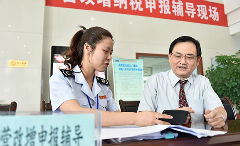VAT reform triggers vitality of enterprises
2016-12-14
english.gov.cn
Replacing the business tax with value-added tax (VAT), as a move to reduce enterprises’ tax burdens, can improve supply, streamline administration, and upgrade economic structure.
During the initial stage of VAT reform, in transportation sectors, clients chose large-scale transportation enterprises for a higher VAT reduction. This prompted small enterprises to seek integrated development, achieving an increase in business volume and a higher tax reduction.
By reducing the marginal costs and improving the supply, the market can better play a “decisive” role in allocating resources, said Li Wanfu, director of the Institute of Tax Science (ITS), a research arm of China’s State Administration of Taxation.
The tax reform also enables enterprises to innovate operations and provide better products and services. A supply chain management enterprise in Wuxi, Jiangsu province, saved costs from VAT and purchased a number of new freight cars, establishing the city’s first intelligent logistics platform based on credit rating, which has now integrated 360 transportation lines and 18,000 registered members.
With new technology, industry, format and business modes that come along with VAT reform, private economy and small and micro businesses are in a more relaxed environment, said Vice-Finance Minister Shi Yaobin.
Meanwhile, experts said the VAT reform launched in 2012 coincided with the establishment of a consumption-based VAT system, which has connected VAT reduction chains in the secondary and tertiary industries, saw the integrated development of manufacturing and service sectors, and promoted upgrading the economic structure.
VAT levying is also part of the reform of streamlining administration, delegating power, strengthening regulation and improving service. Since China extended VAT to all sectors on May 1, taxation bureaus rolled out a series of measures to simplify and speed up the tax filing process.
Statistics indicate that State taxation and local taxation bureaus added 17,386 more tax filing windows, and over 20,000 tax officers. In addition, over 6,000 coaching teams have been set up, and 70 million messages were sent to instruct taxpayers on how to issue invoices.

